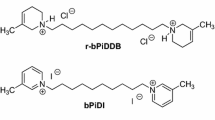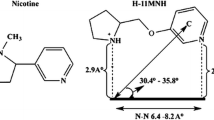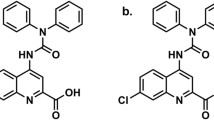Abstract
This study describes the synthesis, receptor binding characteristics, and some behavioral effects of p-bromoacetamidoprocaine (BAP), a new affinity ligand for brain muscarinic and nicotinic cholinergic receptors. The reversible binding of [3H]QNB to rat brain membranes was inhibited in a concentration dependent and saturable manner by both procaine and BAP, with Ki values of 4×10−6 and 3×10−7 M, respectively, and complete inhibition at 1×10−5 M. Both procaine and BAP, although at much concentrations, inhibited the binding of [3H]methylcarbamylcholine in a concentration dependent manner, with Ki values of 5×10−5 and 1×10−5 M, respectively, and complete inhibition for both at 1×10−3 M. Plots of the % irreversible inhibition of [3H]QNB, [3H]nicotine, and [3H]MCC vs [BAP] yielded Ki values of 7×10−8, 1×10−4, and 6×10−5 M, respectively. In behavioral studies BAP was able to antagonize the QNB-induced hyperactivity in mice; however, BAP did not appear to alter nicotine-induced seizure activity or other behavioral effects in mice. A plot of the time course of inhibition by BAP for [3H]QNB binding revealed that the inhibition was almost complete within 10 min exposure at 37°. The findings indicate that BAP is a useful affinity ligand for examining the biochemical and functional characteristics of brain cholinergic receptors, particularly the muscarinic which has an affinity near the nM concentration range.
Similar content being viewed by others
References
Shiono, S., Takeyasu, K., Udgankar, J. B., Delcour, A. H., Fujita, N., and Hess, G. P. 1988. Regulatory properties of acetylcholine receptor: evidence for two different inhibitory sites, one for acetylcholine and the other for a noncompetitive inhibition of receptor function. Biochemistry 23:6889–6893.
Udgankar, J. B., and Hess, G. P. 1986. Acetylcholine receptor kinetics: chemical kinetics. J. Membr. Biol. 93:93–109.
Forman, S., and Miller, K. W. 1989. Procaine rapidly inactivates acetylcholine receptors from Torpedo and competes with agonist for inhibition sites. Biochemistry 28:1678–1685.
Potsma, S. W., and Catterall, W. A. 1984. Inhibition of binding of [3H]-batrachotoxinin-A 20-alpha-benzoate to sodium channels by local anesthetics. Mol. Pharmacol. 25:219–227.
Hisayama, T., Takayanagi, I., Naomi, K., and Haruichi, K. 1989. Interaction of 8 (N,N diethylamino)octyl 3,4,5-trimethoxybenzoate hydrochloride, ryanodine and procaine with muscarinic cholinergic M2 receptor sites in smooth muscle. J. Pharmacol. Exp. Ther. 249:646–651.
Abood, L. G., Reynolds, D. T., Booth, H., and Bidlack, J. M. 1981. Sites and mechanism of nicotine's action in the brain. Neurosci. Biobehav. Rev. 5:479–486.
Banerjee, S., Punzi, J. S., Kreilick, K., and Abood, L. G. 1990. [3H]-Mecamylamine binding to rat brain membranes. Biochem. Pharmacol. 40:2105–2110.
Conti-Tronconi, B. M., and Raftery, M. A. 1982. The nicotinic cholinergic receptor: correlation of molecular structure and functional properties. Ann. Rev. Biochem. 51:491–530.
Fukuchi, I., Kato, S., Nakahiro, M., Uchida, S., and Yoshida, H., 1987. Blockade of cholinergic receptors by an irreversible antagonist. Brain Research 400:53–61.
Langenbuch-Cachat, J., Bon, C., Mulle, C., Goeldner, M., Hirth, C., and Changeux, J. P. 1989. Photoaffinity labeling of the acetylcholine binding sites on the nicotinic cholinergic receptor by an aryldiazonium derivative, Biochemistry 27:2337–2345.
Abood, L. G., and Grassi, S. 1986. [3H]-Methylcarbamylcholine, a new radioligand for studying brain nicotinic receptors. Biochem. Pharmacol. 35:4199–4202.
Bidlack, J. M., Frey, D. K., Seyed-Mozaffari, A., and Archer, S. 1989. 14-(Bromoacetamido)morphine irreversibly labels mu opioid receptors in rat brain membranes. Biochemistry 28:4333–4338.
Varanda, W. A., Aracava, Y., Sherby, S. M., Van Meter, W. G., Eldefrawi, M. E., and Albuquerque, E. X. 1985. The ACh receptor of the neuromuscular junction recognizes mecamylamine as a noncompetitive antagonist. Mol. Pharmacol. 28:128–137.
Endo, M., Kitazawa, T., and Yagi, S. 1980. Different features of responses of the sarcoplasmic reticulum in cardiac and smooth muscles. Pages 447–463,in (ed.) S. Ebahsi, K. Maruyama and M. Endo, Muscle Contraction: Its Regulatory Mechanisms, Japan Scientific Society Press, Springer-Verlag, Berlin.
Itoh, T., Kuriyama, T., and Suzuki, H. 1981. Excitation-contraction coupling in smooth muscle cells of the guinea pig mesenteric artery. J. Physiol. (Lond) 321:513–535.
Creveling, C. R., Bell, M. E., Burke Jr., T. R., Chang, E., Lewandowski-Lovenberg, G. A., Chong-Ho Kim, Rich, K. C., and Daly, J. W. 1990. Procaine isothiocyanate: an irreversible inhibitor of the specific binding of [3H]-batrachotoxinin-A benzoate to sodium channels. Neurochem Res 15:441–448.
Author information
Authors and Affiliations
Rights and permissions
About this article
Cite this article
Saraswati, M., Hashmi, M. & Abood, L.G. 4-Bromoacetamidoprocaine: An affinity ligand for brain muscarinic and nicotinic cholinergic receptors. Neurochem Res 17, 247–252 (1992). https://doi.org/10.1007/BF00966666
Accepted:
Issue Date:
DOI: https://doi.org/10.1007/BF00966666




